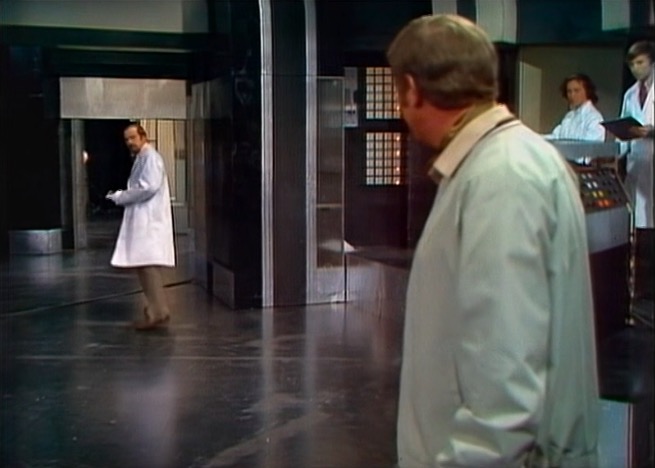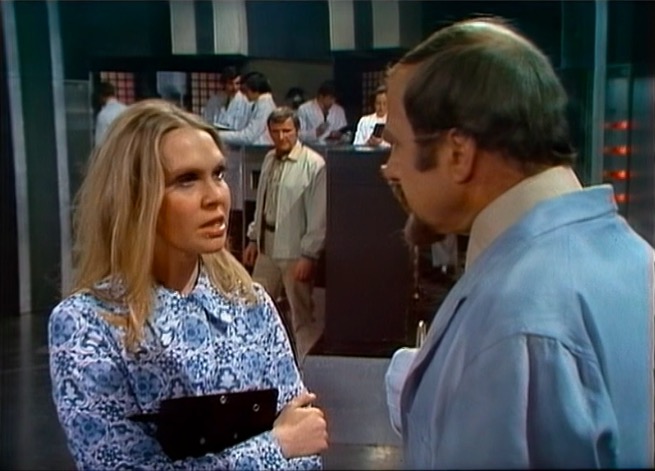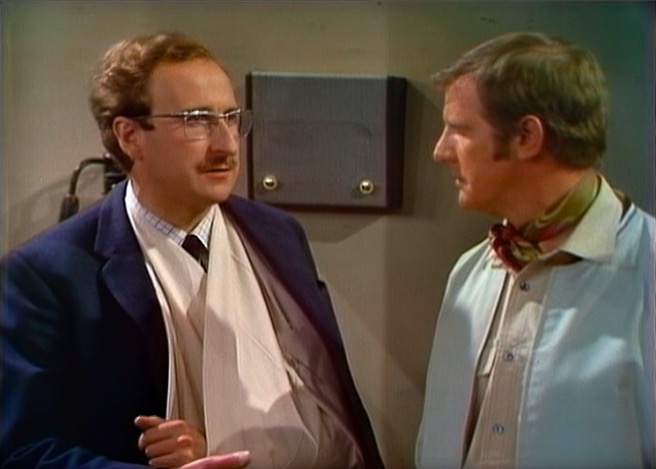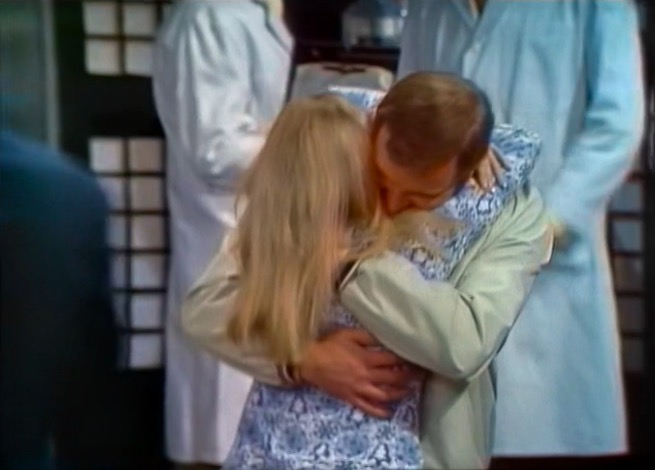The morning after the night before.
EPISODE DISCUSSION
The recap is very quick, and the jump cut between worlds is perfect. There is the sound of destruction, and then suddenly it is quiet. In fact, it did make me think about the choice of audio effects in those last moments, as the dominant sound is not boiling hot lava, or atmospheric conditions, but an ascending and descending electronic noise. Perhaps it’s the TARDIS feeding off the nuclear power, or perhaps it is simply a creative illustration of what the last moments of a world sounds like.
Back on our Earth, all might be quiet, but this is ‘Inferno’, and soon enough, we have the eerie ambience of ‘The Delian Mode’ to keep us company.


We jump back to the dull roar of central control. There is over three hours to go, and it all feels so familiar. It’s as though episode three is repeating itself. But in this tale of parallels, it needs to.
Having been away from the events on our Earth for so long, I’m picking up on details I’d not previously considered, or simply forgotten about; Petra’s patterned attire, Sutton’s silk cravat, the mix of ethnicities in the background.


Speaking of the supporting artistes, I love the fact that it is Keith Ashley who helps Stahlman into his coat. Previously, in episode five, we see his character being dunked in the green goo, by the ‘extra N’.


During the scenes of the Professor’s mental attack, I’m enjoying how the extras are being directed to react to his distress. Perhaps they can see that his liver is really getting the better of him.


Now we are back on our Earth, I can see how the Brig and Liz look so chummy together. It’s amazing what you forget after four episodes of a very different situation. They’re quietly spoken, civilised, and when they disagree, it’s all very cordial.


Unlike Sutton, who gives Stahlman both barrels.
“YOU CAN BLOW YOURSELF TO KINGDOM COME!” Oh! That was wonderful, in the same way that Jimmy finally tells his boss where to go in ‘Quadrophenia’.


The only problem is, it’s Stahlman, a character who is incapable to relating to anyone other than himself, and his pet calculations.
As usual, I’m looking for things that break the magic. The camera and operator behind Petra does the trick. I’m such a philistine.


Number two output pipe does its thing. Right on cue.
I love the impatience of the Brig as he tries to make sense of the person on the other end of the phone. “Yes, yes, yes. Go on!”


And it’s Petra who makes a different type of call, against the wishes of her boss. It’s another nod to her ability to lead a situation when required – another parallel.


The Doctor awakes. “You know you really do look better with that moustache.” That made me laugh out loud, helped along by the Brigadier’s stright “Delierious, poor chap”.


Seconds later, the Brig and Liz look at each other again, as the Doctor utters “Brigade Leader”, but it’s no laughing matter, as the Doctor reminds them and us, that there is a mutating technician still at large on the complex. Although the Doctor would appear to be incorrect – on this Earth he/it hasn’t actually killed anyone yet. Perhaps I need to stop being so unreasonably nit-picky.


Sir. Keith appears. I love the moment where the Doctor realises that time doesn’t always run parallel. Pertwee’s finger biting, and fixed stare convey the endless possibilities in the Doctor’s mind.
It’s a lovely Doctor Who moment. And goodness, ‘Inferno’ needs some glimmer of hope. I wonder if any of the audience, who remained loyal to season seven at the time of transmission, were slightly fatigued by the bleakness of Doctor Who at this point.


And with that – halfway through the episode – it’s time for the Doctor to get out of the hut and stir things up.
We have a reminder of what the Doctor has seen. I really like the hysteria behind his destruction of the control panel in central control, and I love how Private Wyatt’s twin brother is one of the two guards to drag him out.


And Stahlman is following suit in losing the plot. This time it’s a bigger deal. Again all eyes are on the extras, who do a really neat job of expressing the “what the f**k is going on” vibe. This is far more than a liver complaint.


On film, the Doctor gets the better of Terry Walsh and Derek Martin, with a spot of Venusian Ooja. At the tail end of Pertwee’s first season, he is very much in his stride. The calm assured demeanour as he pinches his UNIT captors, is a far cry from the terrified on the run Doctor of episode three.


But the Doctor is on the run once more, and with highly atmospheric, stark, eerie piano chords ringing out occasionally, and accompanied by some lovely lighting and shadows, he starts to climb a ladder.


We know this isn’t a good idea.


I hope you will forgive my indulgence now.
As mentioned in my blog post on episode 1, the encounter with Bromley is one of my favourite scenes in all of Doctor Who. It’s the scene that captured the imagination of illustrator Nick Spender for the Target novelisation, and with that, captured my imagination in a library when I was six or seven years old.


The sparse chime of the piano, the ambient hum, the stream, the soot, the wind, and Ian Fairbairn’s rather fine facial expressions all add up to an dramatic scene.


It also breaks up the monotony of the action within central control for a few minutes, and it’s a final reminder of Inferno’s excellent film work, alongside Douglas Camfield’s ability to direct action like no other. He uses POV shots, 4th wall breakers, whip-crack zooms, and rapid quick-fire editing.


Compare this to a similar scene in ’Terror of the Zygons’ and we can see Camfield’s visual flair, and how he structures a scene like this.
The final actor I’m going to talk about is Ian Fairbairn. His telefantasy credentials are pretty strong, but it’s his range of facial expressions that are the highlight for me. He comes face to face with Adam Adamant in the episode ‘The Last Sacrifice’ where he becomes one of the very few members of the death-by-steering-wheel club. It’s an enjoyable scene where he gets some creepy assassin facial expressions, and a lovely little exchange of glances while in mid-fight.


He lurks nicely in the background in The Lotus Eaters – ‘A Kind of Treason’ and also enjoys some good stares in ‘Timeslip’.


He also gets a glorious moment in the first recorded episode of ‘The Professionals’ where he has his coffee spiked, and enjoys another wide eyed stare, before indulging in a very final “I CAN FLY” moment.


But it’s Doctor Who which still sticks in my mind, as Gregory stares death in the face in ‘The Invasion’.


And as a footnote, he plays a little part as a security guard, in Peter Grimwade’s “probably dissing JN-T” dramarama ‘The Come-uppance of Captain Katt’ (TVS, 1986), including a lovely moment with an alien overlord. Yep, this man of many stares, has seen it all.


Inside the drill head, Stahlman smears goo on his face, like I smear chocolate cake on mine, when no one is looking.


A little smattering of film, turn the temperature up, and there we have it, a fully transformed Professor. Aside from tennis matches, I wonder if Camfield collaborated with head-strong Pooley after this?
Ian Fairbairn’s warm tones ring out again as the countdown begins. And there in the background is the Doctor awaiting his cue.


Sir Keith does a U-turn. A few moments ago it is suggested he is able to return to the complex and stop the drilling. But now, he is unable to. Apparently there is a need to prove that there is an emergency.


But mercifully for everyone concerned, it is Stahlman who offers it, by revealing himself to his adoring audience. Very sweet of him not to lock the technicians in with him this time.
And he uses props for his magic show too. A collapsing chair, a blast of dry ice, and a round of blanks.


And in death, he reveals a little more – a patch of neck without make up.
Petra starts to shut down the drill, and is informed by Christopher D’Oly John, Berry Letts and others of the status of this.


But it’s still drilling!
It’s simply because we need our Doctor to complete the final redemptive act, and get his screwdriver out.


If there is an element of the episode I find disappointing, it is this moment, which simply involves the Doctor fixing the buffer controls, and then a long shot of a triumphant walk back into central control. I wanted to see the effect that the destruction of the parallel world had on the Doctor, after all it would clearly linger in his memory during ‘The Mind of Evil’. In my head, the Doctor is having some kind of flashback, with the sound of explosions and rumbling, at the same time he is trying to fix the control unit.


Sure, Greg and Petra are going to enjoy some penetration of their own once they have driven back to London. But look at the affection in the embrace between the Doctor and Liz Shaw. I’m really going to miss her. They made a great team.


OK, so the final scene isn’t going to win any awards for ‘greatest ending in Doctor Who’, but it’s not as bad as many have made out. In fact the Brigadier’s “I’ll be around for a while yet” is incredibly funny, as is the Doctor’s underwhelmed reaction. Sometimes, just sometimes, after seven episodes of high octane drama, and unremitting grimness, it is nice to have a happy ending.


And when you consider the main weakness of the otherwise excellent Blake’s 7 was 48 of it’s 52 episode endings (the season finales escape this tag) ‘Inferno’ looks amazing in comparison!
But it’s a future without Liz Shaw. She’s been an excellent innovation – a contemporary thinker in a contemporary world. She was never bullied by anyone, and could also play the part of ‘assistant’ to the Doctor. She was a strong character, and responsible for a lot of the success of this season. Her final words, a stifled, giggled “Oh dear”, is a line I’m very fond of.


But as much as, in a parallel world, I would like much more of Doctor Who to be this gritty, it was right for the tone to change towards a more comfortable format, that can pull in more children, and their childlike parents. Barry Letts, like Graham Williams several years later, understood that Doctor Who should never take its eye off being an accessible format for the whole family. These are the decisions that ensure the longevity of the show. The end of ‘Inferno’ is the end of an era. But the wonderful thing about this show, is that there is nothing to say it can’t be like that again in the future.
And what if it had been the last scene recorded ever? What if Doctor Who had ended with this story? Well, I couldn’t think of a better scene. Like Survival almost 20 years later, Doctor Who shouldn’t end with a bang, it’s got too much work to do.


EPISODE ANALYSIS
Episode seven is about familiarity. Somehow this is seen as a weakness in many examples of narrative storytelling, but it’s essential for ‘Inferno’ – a story of parallels and repetition. Those who criticise this final instalment for not telling a new story, or lacking the ‘punch’ of other episodes are missing the point. I think the audience needs to be taken on this familiar ride, and in fact, there are many times where I really enjoyed the anticipation of the Doctor climbing the ladder, the lowering of the drill head heat shield, and the final race against time to stop penetration zero. This familiarity is exactly what ‘Inferno’ is about, and episode seven, for my money, is one of the strongest episodes as a result. We know the stakes. What we don’t know is how the Doctor will save the world.
I’d like to finish, by returning to where I began – what it felt like to witness ‘Inferno’ for the first time. The novelisation was the way in, however watching it for the first time in the 1990’s was also a revelation, due to the way it looked.
The quality of that video print adds to the mystery of the ‘Inferno’. As you will probably know, it was returned to be BBC from North America in the mid 1980’s, as 525 line NTSC copies. The result was a washed out, slightly blurry picture.




As amazing as the Restoration Team’s efforts to return it to its original glory (and I am genuinely in awe of this) occasionally, there are times when I wish there were forces that mankind shouldn’t tamper with. The clean pristine ‘Inferno’ is a technological marvel, but just lacks a little bit of the cold, desaturated, distant blurriness that made my first watching of it feel that little bit more inaccessible, and less cozy – perfect for the story, and just like the tone of Doctor Who around this time.


I think it was Paul Cornell who once said something along the lines of how ‘Inferno’ was great, but you wouldn’t want all Doctor Who to be like this. I think that is a fair assessment. But ‘Inferno’ holds a special place in my heart, for its scare factor, and the fact that it was my way into ‘old’ Doctor Who – another world from the one I was used to.

And the central premise is still too close to real life, to be unbelievable. Now more than ever.

Hey this blog’s really good. Enjoyed it a lot. Thanks…
LikeLike